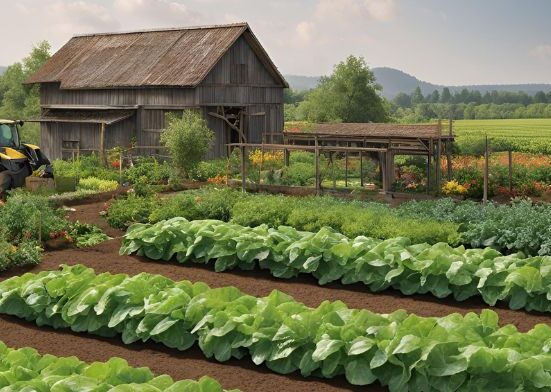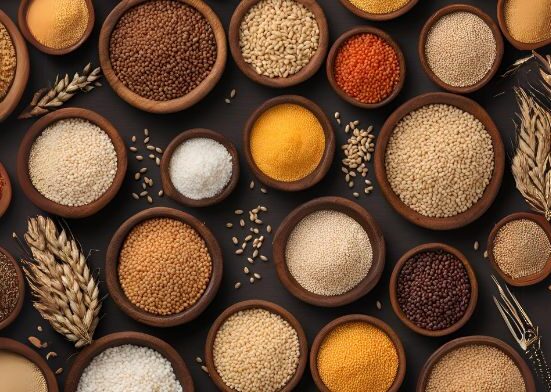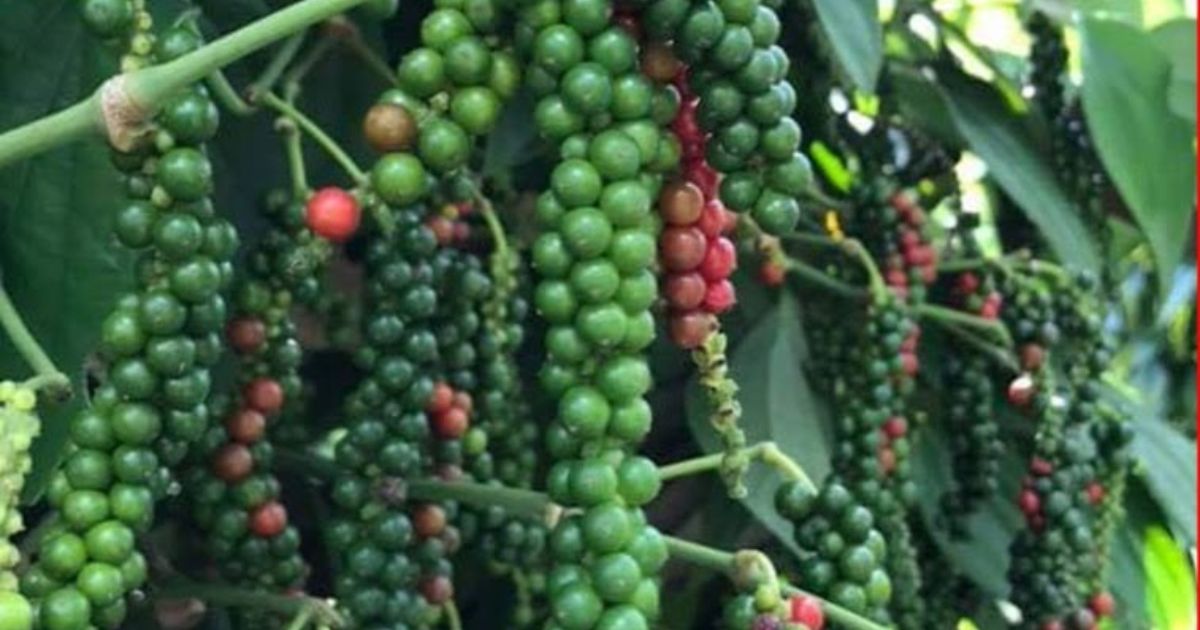Black pepper, often called the “King of Spices,” is one of the most widely used and cherished seasonings in the world. From adding a bold kick to savory dishes to offering health benefits like improving digestion and boosting metabolism, this tiny spice has a considerable reputation. What many people don’t realize is that black pepper isn’t just a kitchen staple; it’s also a plant you can successfully grow in your own garden.
With its glossy green leaves, delicate white flowers, and clusters of peppercorns, the black pepper vine not only provides fresh, homegrown spice but also adds a touch of tropical beauty to your garden. Whether you’re a gardening enthusiast or want to enjoy the satisfaction of harvesting your own spices, learning how to grow black pepper is both fun and rewarding.In this guide, we’ll walk you through everything you need to know from choosing the right spot and preparing the soil to planting, caring for, and harvesting your peppercorns so you can enjoy fresh, flavorful black pepper plant straight from your garden.
Why Grow Black Pepper?
Before we dig into the how-to, let’s explore why growing a black pepper plant is worth your effort. Black pepper adds unmatched flavor to meals, and homegrown peppercorns are fresher and more aromatic than store-bought versions. Plus, the plant’s lush, glossy leaves and climbing vines make it a stunning addition to your garden or patio. Growing black pepper also connects you to a global tradition. Fastest Growing Vegetables for Your Garden Pepper has spiced up cuisines for centuries, from ancient trade routes to modern kitchens.
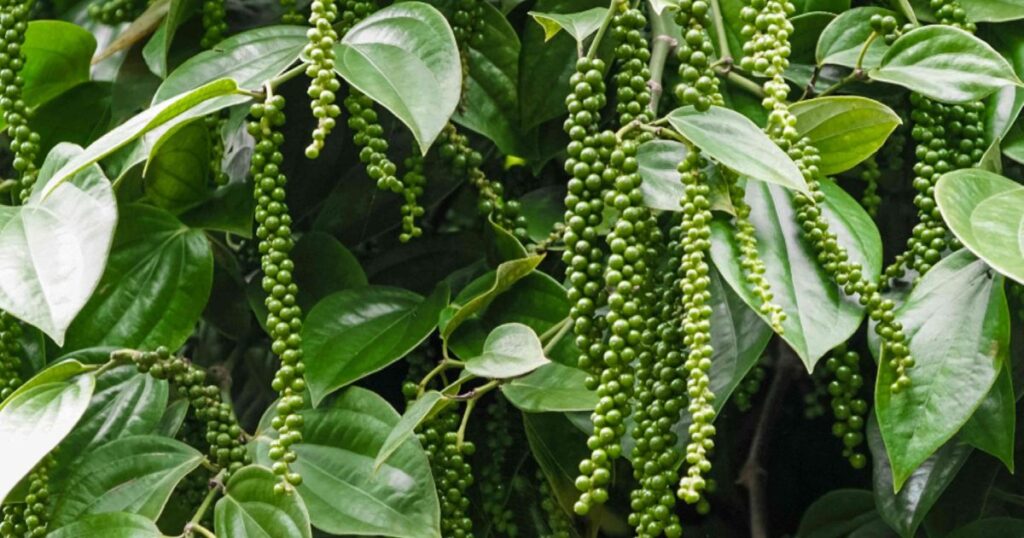
This tropical perennial thrives in warm, humid climates but adapts to containers or greenhouses in cooler regions. Whether you’re a seasoned gardener or a curious beginner, cultivating black pepper is an exciting challenge that pays off with both beauty and flavor.
Understand the Black Pepper Plant
Piper nigrum is a woody, climbing vine native to India’s Malabar Coast. It produces small, round peppercorns that start green, turn red, and become black when dried. The plant loves heat, humidity, and partial shade, making it ideal for tropical or subtropical gardens. In colder climates, you’ll need a greenhouse, an indoor setup, or a warm microclimate to mimic its natural habitat.
The plant grows up to 13 feet tall but is often kept smaller in cultivation. It needs support, like a trellis or pole, to climb.peppercorn plant take 3–5 years to produce peppercorns, so patience is key. With proper care, your plant can yield fresh pepper for years.
Choose the Right Variety
Not all black pepper plants are identical. Several cultivars exist, each suited to specific climates or growing conditions. Popular varieties include:
- Malabar: Known for its robust flavor, this variety is ideal for warm, humid climates.
- Tellicherry: Produces larger, more aromatic peppercorns, perfect for gourmet dishes.
- Lampong: A hardy variety from Indonesia, great for beginners.
Research which variety suits your climate and taste preferences. If you’re in a colder region, opt for a hardy cultivar and plan to grow it in a pot for indoor overwintering.
Gather Your Supplies
To grow a black pepper tree, you’ll need the following:
- Seeds or Cuttings: Black pepper is typically propagated from cuttings, as seeds are less reliable and take longer to germinate. Source healthy cuttings from a nursery or online supplier.
- Pot or Garden Space: Use a 12–18-inch pot with drainage holes for container growing or prepare a garden bed in a warm climate.
- Support Structure: A trellis, stake, or pole for the vine to climb.
- Soil: Well-draining, loamy soil rich in organic matter (pH 5.5–6.5).
- Fertilizer: Organic compost or a balanced fertilizer (10-10-10 NPK).
- Watering Can or Hose: For consistent moisture.
- Mulch: Organic mulch, such as bark or straw, helps retain soil moisture.
- Pruning Shears: For maintaining the plant’s shape and health.
Invest in quality supplies to give your ground pepper plant a strong start.
Start with Seeds or Cuttings
Seeds
Black pepper plants black seeds are challenging to germinate, but here’s how to try:
- Source Fresh Seeds: Purchase seeds from a reputable supplier or harvest them from ripe (red) peppercorns.
- Soak the Seeds: Soak seeds in lukewarm water for 24 hours to soften the outer coating.
- Plant the Seeds: Sow seeds ¼ inch deep in a seed-starting mix. Keep the soil moist and warm (75–85°F or 24–29°C).
- Provide Light: Place the tray in a bright, indirect light spot. Germination takes 30–60 days, so be patient.
- Transplant: Once seedlings have 4–6 leaves, move them to pots or your garden.
Cuttings (Recommended)
Cuttings are faster and more reliable:
- Select a Healthy Cutting: Choose a 6–8-inch cutting with 2–3 nodes from a mature black pepper plant.
- Prepare the Cutting: Remove lower leaves, leaving 1–2 at the top. Dip the cut end in rooting hormone (optional but helpful).
- Plant the Cutting: Insert the cutting into a pot filled with a mix of perlite and peat moss. Keep the soil moist.
- Create Humidity: Cover the pot with a plastic bag to trap humidity, ensuring the cutting doesn’t touch the plastic.
- Wait for Roots: Place the pot in a warm, shaded area. Roots form in 4–8 weeks. Transplant once the cutting has a strong root system.
Cuttings give you a head start and increase your success rate.
Choose the Perfect Location
Black peppercorn plants thrive in specific conditions:
- Light: Provide bright, indirect sunlight or partial shade. Avoid harsh, direct sun, which can scorch leaves.
- Temperature: Maintain 65–85°F (18–29°C). Protect the plant from temperatures below 60°F (15°C).
- Humidity: Aim for 60–80% humidity. In dry climates, mist the plant or use a humidity tray.
- Support: Install a trellis, pole, or fence for the vine to climb. Boosting Soil Health: Ensure it’s sturdy, as the plant grows heavy with age.
For outdoor gardens in USDA zones 10–12, plant in a spot with morning sun and afternoon shade. In cooler zones, grow in a pot to bring peppercorn vegetable indoors during winter.
Plant Your Black Pepper
In the Garden
- Prepare the Soil: Amend the soil with compost or well-rotted manure to improve fertility and drainage.
- Dig a Hole: Make a hole twice as wide and deep as the root ball.
- Plant: Place the peppercorn vine in the hole, ensuring the root ball is level with the soil surface. Backfill and press gently.
- Water Thoroughly: Soak the soil to settle the roots.
- Add Support: Install a trellis or pole next to the peppercorn bush for climbing.
In a Pot
- Choose a Container: Use a pot with drainage holes, at least 12 inches wide and deep.
- Fill with Soil: Use a mix of loamy soil, compost, and perlite for drainage.
- Plant the Cutting or Seedling: Place it in the center, covering the roots completely.
- Water Well: Keep the soil moist but not soggy.
- Add a Stake: Insert a small stake or trellis for the vine to climb.
Care for Your Black Pepper Plant
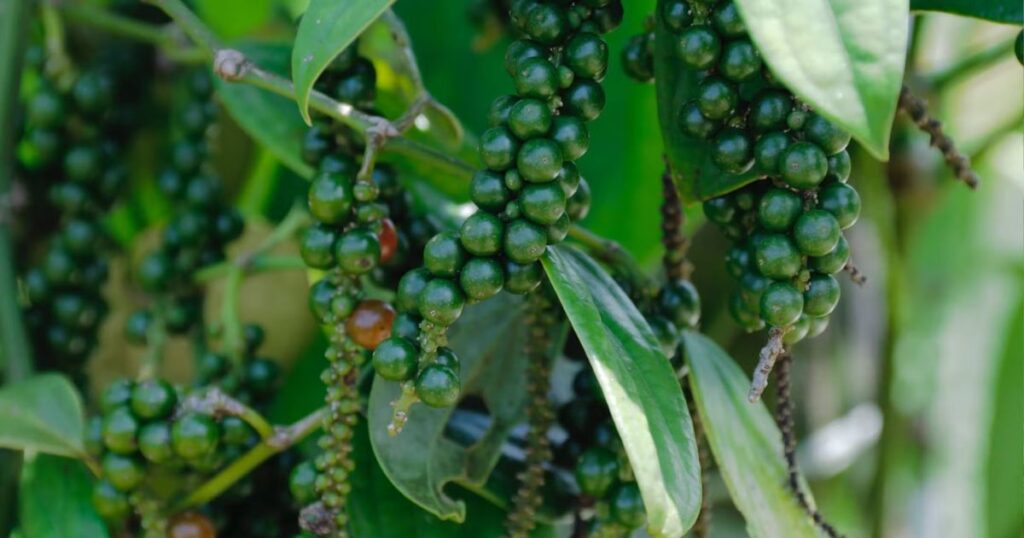
Proper care ensures your plant thrives and eventually produces peppercorns.
Watering
- Keep the soil consistently moist but not waterlogged. When the pepper corn plant soil’s top inch feels dry, water it.
- In hot weather, water daily. In cooler months, reduce to every 2–3 days.
- Avoid overwatering, as it leads to root rot.
Fertilizing
- Feed every 4–6 weeks during the growing season (spring and summer) with a balanced 10-10-10 fertilizer or compost tea.
- Reduce feeding in fall and winter when growth slows.
Pruning
- Trim dead or yellowing leaves to encourage healthy growth.
- Pinch back the tips of young vines to promote bushiness.
- Remove overcrowded stems to improve air circulation.
Pest and Disease Control
- Watch for pests like aphids, spider mites, or mealybugs. Top 8 Vegetables to Plant in Spring for a Thriving Garden Spray with neem oil or insecticidal soap if needed.
- Prevent fungal diseases by ensuring good air circulation and avoiding overwatering.
- Check regularly for signs of root rot or leaf spot, and treat promptly with organic fungicides.
Supporting the Vine
- Train the vine to climb the trellis or pole as it grows. Use soft ties to secure it without damaging the stem.
- As the plant matures, ensure the support can handle its weight.
Overwintering in Cold Climates
If you live in a region with cold winters, bring potted black pepper plants indoors:
- Place the plant near a south-facing window with bright, indirect light.
- Maintain temperatures above 60°F (15°C).
- Use a grow light if natural light is limited.
- Reduce watering and stop fertilizing during winter dormancy.
For garden plants in borderline zones, cover with frost cloth or mulch heavily around the base to protect roots.
Harvest Your Peppercorns
After 3–5 years, your black pepper plant may produce peppercorns. Here’s how to harvest:
- Wait for Maturity: Peppercorns appear as small, green berries on spikes. They turn yellow, then red, as they ripen.
- Harvest Green Peppercorns: Pick green berries for fresh use or to dry into black peppercorns.
- Harvest Red Peppercorns: Pick fully ripe red berries for white pepper (soak and remove the outer skin) or to dry for black pepper.
- Dry the Peppercorns: Spread green or red peppercorns on a tray in a warm, Zinnia Perennial: dry place for 7–10 days until they turn black and shrivel.
- Store Properly: Keep dried peppercorns in an airtight container in a cool, dark place.
Each plant can yield 1–2 pounds of peppercorns annually once mature.
Troubleshoot Common Issues
- Yellowing Leaves: Often caused by overwatering or nutrient deficiency. Check soil moisture and fertilize if needed.
- Slow Growth: Ensure adequate warmth, light, and humidity. Adjust conditions as necessary.
- No Peppercorns: Young plants may not produce for several years. Ensure proper care and patience.
- Pests: Inspect regularly and treat infestations early with organic solutions.
Tips for Success
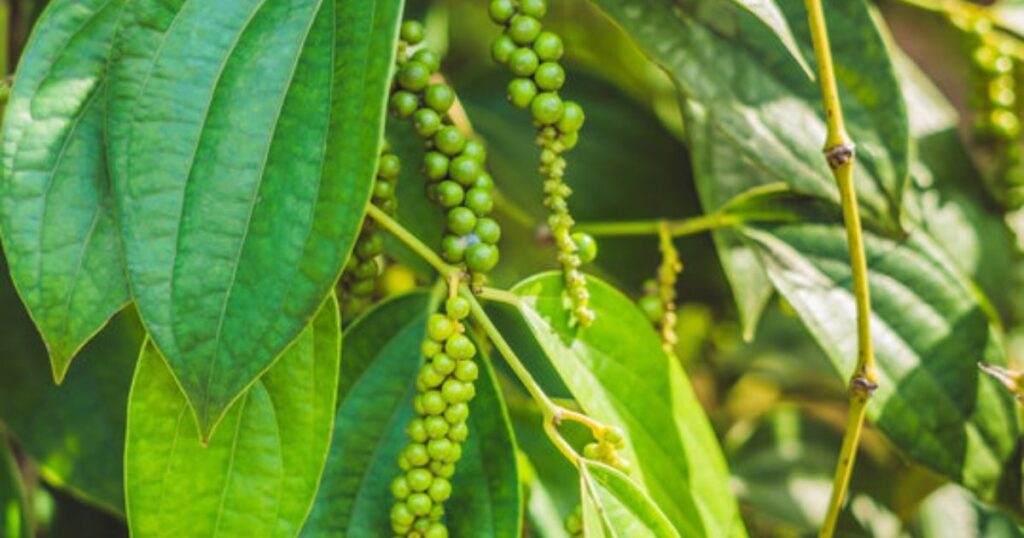
- Mimic the Tropics: Replicate the plant’s native environment with warmth, humidity, and shade.
- Be Patient: Black pepper is slow to establish but rewarding with time.
- Experiment: Try growing multiple plants to increase your harvest.
- Learn from Mistakes: Adjust care based on your plant’s response.
Conclusion
Growing a black pepper plant in your garden is more than just cultivating a spice; it’s an opportunity to connect with nature, embrace sustainable living, and enjoy the satisfaction of harvesting your own flavorful peppercorns. With the right climate, proper care, and a little patience, this tropical vine will reward you with a steady supply of fresh, aromatic pepper that elevates your cooking and benefits your health.
Whether you’re planting in your backyard or in a container on your patio,peppercorns plant brings both beauty and utility to your garden space. From preparing the soil and providing support for its vines to harvesting and drying your own peppercorns, every step of the journey is worth the effort. The Ultimate Guide to Growing Lavender from Seeds So, why settle for store-bought when you can sprinkle homegrown spice on your meals? Start small, nurture your plant, and before long, you’ll experience the joy of adding your very own garden-grown peppercorn plant for sale to the table.
FAQ
Can I grow black pepper in pots or containers?
Yes, you can grow black pepper in pots as long as the container is deep, well-draining, and placed in a warm, humid environment. A trellis or support is also necessary for the vine to climb.
How long does it take for a black pepper plant to produce peppercorns?
Black pepper plants usually start producing peppercorns after 3–4 years of growth, depending on climate and care.
Is black pepper a perennial plant?
Yes, black pepper is a perennial climbing vine that can live and produce for many years with the right conditions.
Do black pepper plants need full sunlight?
No, black pepper prefers partial shade or filtered sunlight. Too much direct sun can stress the plant.
Can I grow black pepper indoors?
Yes, but it requires a warm, humid environment and consistent care. Using a grow light and humidifier can help replicate tropical conditions indoors.




